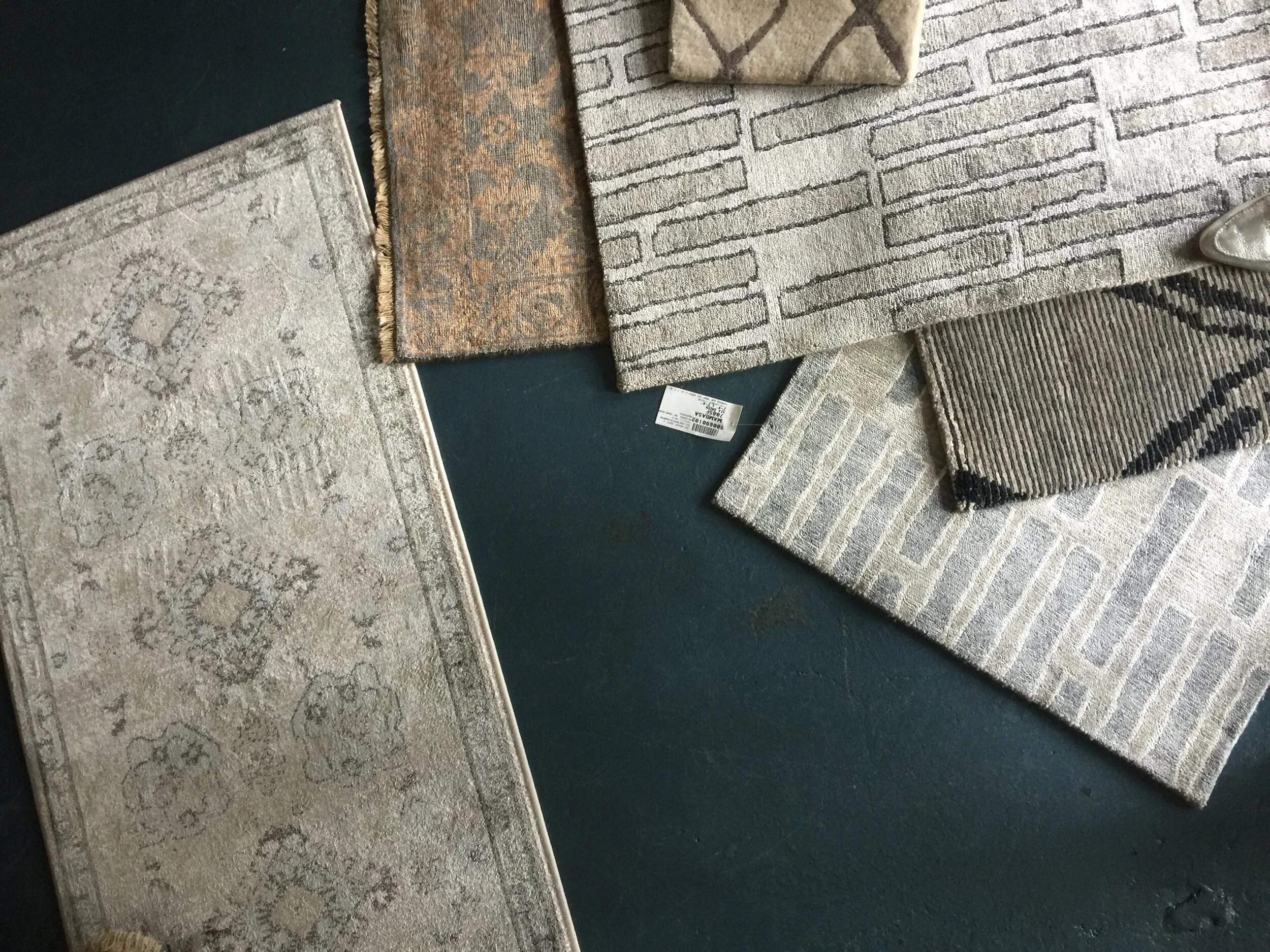Area rug buying guide
Tips for choosing the right size, fabrication and placement of an area rug.
Living Room
• If possible, leave an equal amount of rug exposed around the furniture on at least 2 sides to create balance.
• The rug shouldn’t touch baseboards.
• When furniture is against a wall, place the front legs on the rug.
• Anchor a small space using a rug in the center of your area.
Bedroom
• Rugs can be placed under the bottom two thirds of the bed. This placement allows adequate space for your nightstands.
• In general, when choosing rug sizes for bedroom use this guide: 9×12 for King, 8×10 for Queen, 6×9 for Full, and 5×7 for Twin
Dining Room
• Make sure chairs fit comfortably on the rug from the pulled out position.
• A good rule of thumb is to have at least 30″-36” of rug on all sides of the table.
• Choose low-pile or flat woven rugs in the dining room to prevent tripping and interference with the movement of chairs.
Kitchen
• Place a small rug in front of the sink, a standard size is 2’ x 3’ This protects the floors and provides comfort for leg and feet when working at the sink.
• For larger kitchens, you can use a runner.
• A round rug under a kitchen table can add visual interest. Use a rug made of durable material like Polypropylene.
Cleaning Your Rug
Most area rugs benefit from the following care routine:
Regular vacuuming: this removes dirt and debris, just be sure to not vacuum any fringe.
Brush out pet hair: vacuuming can sometimes leave this hair behind so use a stiff brush to get it out.
Shake it: if your rug is small enough, shake or beat it outside to remove dirt. Just check with neighborhood ordinances to make sure it is ok.
Always blot: if there is a spill, time is of the essence. Blot the mess with water (never rub) and a clean towel.
Professional cleaning: If your rug gets heavy use, once a year will do the trick. In average wear and tear situations, a professional cleaning once every 2-3 years is recommended.
Regular at-home vacuuming will keep your rug in the best shape.
Rug Pads
Rug pads reduce wear and tear and help to absorb the impact of feet and noise. They also make vacuuming easier and protect smooth-surface flooring, like hardwood and laminate, from being scratched.
Rug Construction Terms
Hand Hooked
The weaver pushes a hooking tool through the foundation cloth to the front of the rug, then pulls the yarn to the back, leaving a loop on the surface.
Hand Knotted
Each knot is individually tied by hand. These knots are single strands of yarn that have been looped around two adjacent warp threads.
Loomed
These rugs bear a close resemblance to hand-knotted rugs but are machine-made. The pile is woven between two backings and then split down the middle so you get two seperate rugs.
Tufted
To form the pile, a cloth is put over a loom, then a hand-gun pushes the yarn to the back of the cloth. Then the rug is taken off the loom and a scrim and layer of latex are put on the back. The backcloth is sewed onto the latex and scrim to protect your floors.
Braided
These durable rugs are made of a braid of three or more strips of cloth which is then woven around itself and sewn together.
Kilim
Often made from wool, these rugs are a flat tapestry-woven carpet and often feature diagonal patterns to avoid weakening the structure of the rug.
Needle bond
These rugs are superior quality since they are 100% olefin. They are UV stabilized, durable, and static resistant. Since they come in many color choices, it is easy to coordinate them with any decor.
Shag
Aka ‘Deep Pile’ The shag rug has a deep pile, giving it a shaggy appearance.
Woven
Also known as “flat weaves”, woven rugs are the same front and back, have no pile and are not made from knots.
Pile
Any Rug that has strands of material
Loop
Any rug that has material that has no loose ends but rather loops back down like berber, jute, etc
Rug Material Types
Rugs can be divided into two categories: natural fiber and synthetic fiber.
Natural fiber rugs
Natural fibers, such as wool, cotton or silk, are used in handmade rugs. They are much more durable than mass-produced synthetic rugs and made of the finest quality materials. Natural fibers last longer and release no harmful gasses into the environment over time. They can be hand-knotted, hand-tufted or flat-woven.
Here are four choices for natural rugs:
1. Wool rugs
It should be no surprise that wool, one of the most durable rug options available, is the most popular rug choice among homeowners. It is an extremely versatile fiber that dyes easily and allows for an endless amount of color options, while holding its appearance for a long period of time.
Wool can stand up to traffic and is comfortable on your feet. It’s perfect for families with an active schedule or little ones running around.
Because of its dense properties, wool naturally repels liquids. Eventually it will absorb the moisture, but it does take some time, allowing for a quick cleanup to avoid permanent damage.
It typically creates a thicker rug and is prone to piling or shedding, but is available in a flat weave option as well. It is recommended to have wool rugs professionally cleaned when necessary.
2. Cotton rugs
Cotton is another fiber that dyes easily and allows for many colors. Cotton rugs are typically braided or flat weave, and they are a softer alternative to jute or sisal rugs. They are fairly durable and are often machine-washable.
Cotton rugs are less expensive than wool rugs and have a more casual look. This makes them a good choice for busy families on a budget.
3. Jute and sisal rugs
Jute and sisal create tough, very durable rugs. The construction of these rugs allows for textures and weaves that other types of fiber normally cannot achieve. Jute and sisal are a good alternative if someone has a wool allergy.
Keep in mind that rugs of these materials are more coarse and rough on your feet compared to wool or cotton rugs. They also will absorb moisture, making it difficult to remove stains.
4. Silk and viscose rugs
Silk and viscose are very soft, easy to dye and absorbent materials. Though they are versatile, they not very durable on their own. They work well in a combination with wool. Their fibers create depth and give rugs a beautiful sheen.
Synthetic fiber rugs
Synthetic rugs are typically machine-made and woven on a power loom. With machine-made rugs, you have the ability to customize the size, colors, patterns, etc. The details are entered into a computer, and a rug forms exactly how you want.
Here are three choices for synthetic rugs:
1. Nylon rugs
Nylon is a manufactured fiber that can transform into a limitless amount of colors. It resists dirt and crumbs, and you can easily clean it. It is a very strong and durable fiber that stands up well to heavy traffic. It also has a silky appearance that will create a nice sheen in area rugs.
However, nylon is often acid dyed. This can lead to fading and other long-term issues.
2. Olefin/Polypropylene rugs
Olefin (polypropylene) is the most popular manufactured fiber used in rugs. It is soft like wool, stain-resistant, holds color well and is affordable. Due to its durability and ability to repel stains and moisture, olefin is often used in outdoor settings.
It is not a resilient fiber. Furniture marks can prove difficult to fix, and high-traffic areas tend to show soiling and abrasion over time.
3. Polyester rugs
Polyester is a very durable manufactured fiber used in rugs. It is solution dyed and therefore very resistant to bleaching, fading and other wear and tear. It is inexpensive and often very popular among producers.
However, polyester is difficult to dye, so colors and patterns are more limited. Polyester also is not oil-resistant. If oil-containing substances are left on the rug, they are likely to combine with the polyester fibers leaving permanent stains


